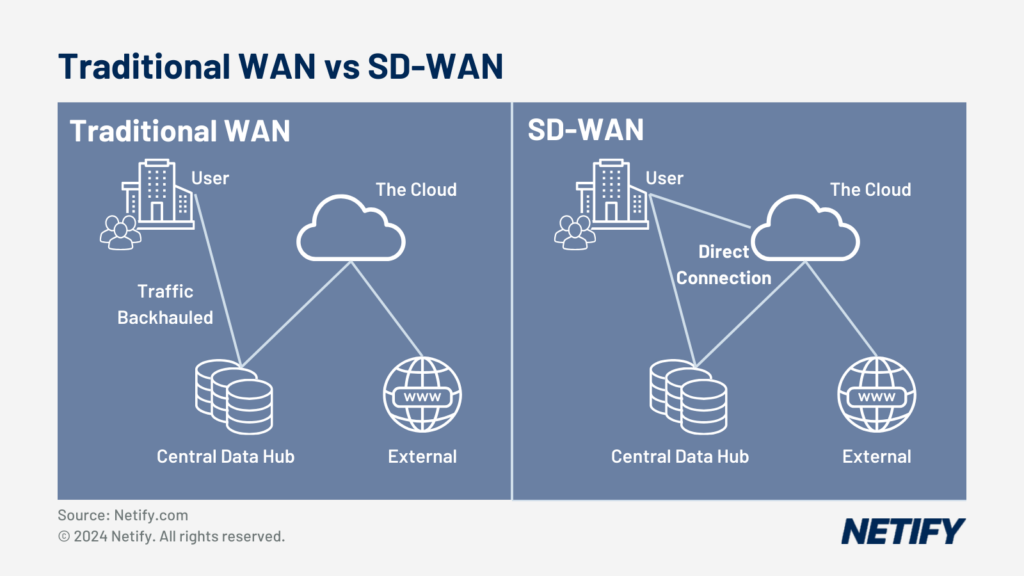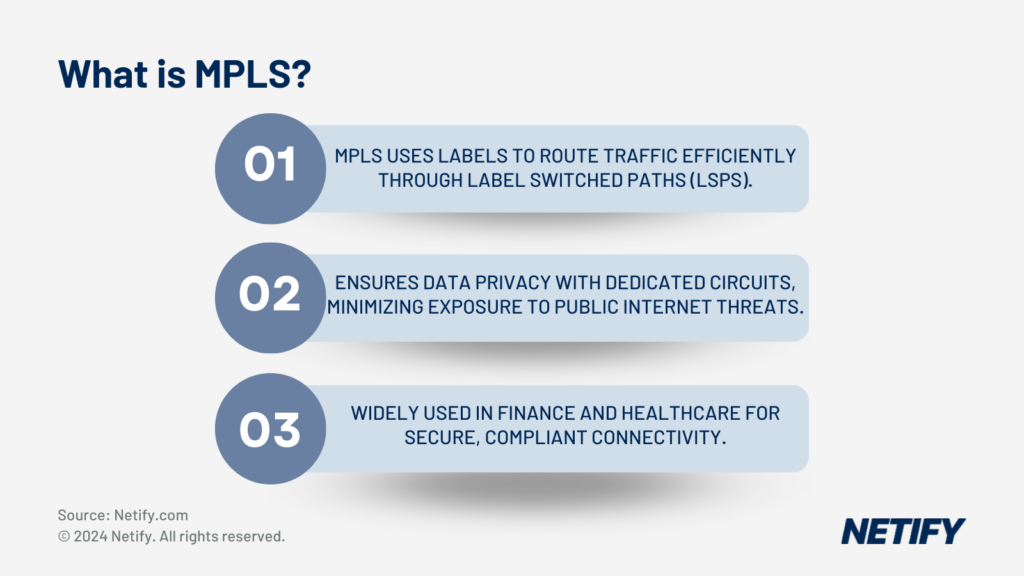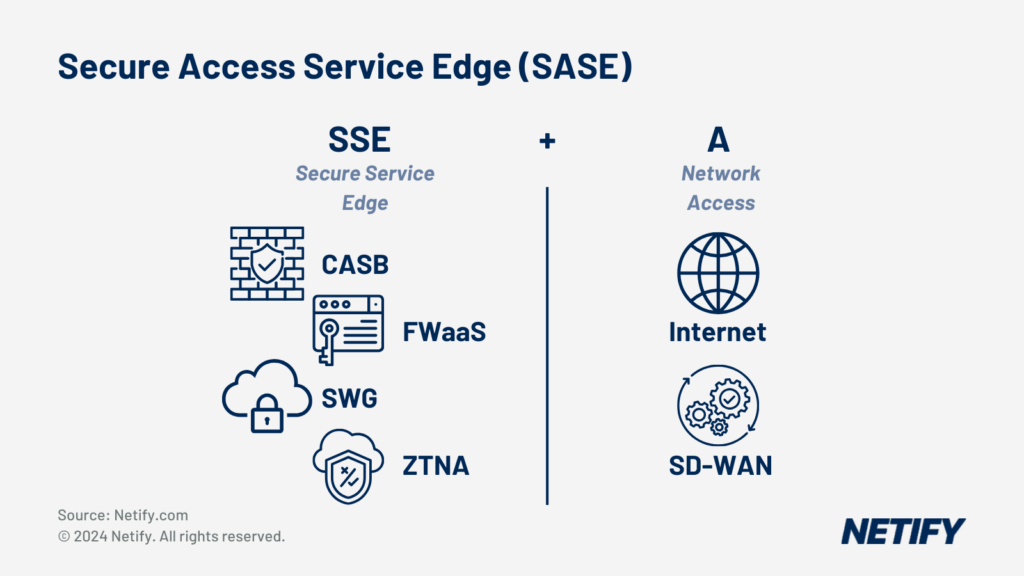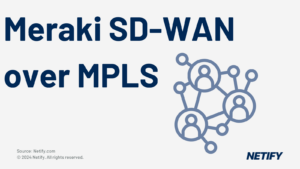SD-WAN offers flexibility, cost efficiency and integrated security. Meanwhile MPLS provides reliability and guaranteed performance. Combining both in a hybrid solution maximises network effectiveness. |
Despite being viewed as outdated, when comparing SD-WAN with MPLS, many businesses only consider MPLS for its well-known reliability. This article explains why SD-WAN not only offers more cost-effective performance but also how it integrates application-aware routing, additional security through SASE and how it can leverage MPLS circuits. Due to the advanced functionality of SD-WAN, IT decision makers may wish to ask how they can get the most out of SD-WAN with MPLS rather than which sole option is better.

Traditional Wide Area Networks (WAN) typically utilise MPLS circuits, which were important for connecting geographically dispersed locations such as branch offices and data centres. This enabled high performance access to network resources and improved operational efficiencies.
However, in recent years organisations have increasingly began to utilise the cloud and transition to remote workforces. This has placed greater emphasis on deciding between whether it was best to leverage Multi-protocol Label Switching (MPLS) solutions or Software-Defined Wide Area Network (SD-WAN) solutions.
Both MPLS and SD-WAN offer differing benefits and drawbacks therefore it is important for IT decision makers to understand the difference, what each provides and how the network architecture affects the cost, performance and security of the network.
Understanding MPLS

What Is MPLS?
Multiprotocol Label Switching (MPLS) routes traffic through Label Switched Paths (LSPs) to route data. This process requires all network packets to be assigned labels indicating their type and importance. These labels simplify the routing process and enable end-to-end traffic management.
MPLS solutions have acted as the backbone of traditional WAN for decades. MPLS utilises private circuits, enabling both Quality of Service (QoS) and Service Level Agreements (SLAs) to be put in place for traffic degradation metrics such as latency and jitter. MPLS ensures data privacy through dedicated circuits, isolating traffic from the public internet and reducing the attack plane for threats.
Industries such as Finance and Healthcare typically rely on MPLS due to the dedicated circuitry offering a ‘closed loop’ of private connectivity, which provides security and reliability when transmitting sensitive data and assists these industries with keeping up-to-speed with regulatory compliance.
SD-WAN vs MPLS Pros & Cons
| wdt_ID | wdt_created_by | wdt_created_at | wdt_last_edited_by | wdt_last_edited_at | Pros | Cons |
|---|---|---|---|---|---|---|
| 1 | hyelland | 29/10/2024 11:43 AM | hyelland | 29/10/2024 11:43 AM | End-to-End Service Level Agreements – Guaranteed performance at pre-defined service levels. | High Cost – Dedicated circuits and specialised hardware can be costly. |
| 2 | hyelland | 29/10/2024 11:43 AM | hyelland | 29/10/2024 11:43 AM | Quality of Service – Prioritises critical applications, providing necessary bandwidth and maximise performance. | Inflexible – MPLS cannot dynamically adapt path selection, requiring manual configuration to alter. |
| 3 | hyelland | 29/10/2024 11:43 AM | hyelland | 29/10/2024 11:43 AM | Reliability and Security – Provides highly reliable and private connections. | Limited Cloud Integration – MPLS has limited direct connections to the cloud and often requires additional infrastructure. |
| Pros | Cons |
Emergence and Advantages of SD-WAN
Software-Defined Wide Area Network (SD-WAN) acts as a virtual network management plane, controlling data flows through software rather than circuits. This enables SD-WAN to utilise multiple connection types (e.g. broadband, cellular) at edge devices, through segmenting traffic based on application priority and QoS to ensure that critical applications are prioritised. Through multiple connection types, SD-WAN can dynamically select paths to route data based on real-time network telemetry and conditions.

Application Performance and Reliability Benefits
By offering connectivity over multiple links SD-WAN improves network flexibility as it reduces vendor lock-in and improves cost-efficiency by making use of more-affordable broadband internet connections, minimising the reliance on dedicated MPLS circuits.
SD-WAN vs MPLS Pro & Cons
| wdt_ID | wdt_created_by | wdt_created_at | wdt_last_edited_by | wdt_last_edited_at | Pros | Cons |
|---|---|---|---|---|---|---|
| 1 | hyelland | 29/10/2024 11:44 AM | hyelland | 29/10/2024 11:44 AM | Cost Reduction – Improves cost efficiency by utilising low-cost broadband options. | No SLAs – SD-WAN does not offer Service Level Agreements as the connection is entirely dependent on the underlying internet, which may provide variable performance. |
| 2 | hyelland | 29/10/2024 11:44 AM | hyelland | 29/10/2024 11:44 AM | Flexible – Enable the use of multiple network connections for redundancy and improved performance. | Initial Deployment Complexity – The initial deployment process can be complex as integration with existing network infrastructure can be challenging. |
| 3 | hyelland | 29/10/2024 11:44 AM | hyelland | 29/10/2024 11:44 AM | Application Aware Routing – Optimises network path utilisation based on real time application requirements. | |
| 4 | hyelland | 29/10/2024 11:44 AM | hyelland | 29/10/2024 11:44 AM | Security – SD-WAN offers built in security features such as encryption and segmentation. | |
| Pros | Cons |
AI Integration in SD-WAN
By integrating Artificial Intelligence (AI) into SD-WAN, it enables predictive analysis of network performance based on real time metrics and historical data. This enables SD-WAN to optimise the network performance in real time and respond to network issues proactively.
Artificial Intelligence has also been integrated into SD-WAN in order to enhance security. These integrations detect threats (including Zero Day) and apply automated responses or notify network administrators before they can cause further damage to the network.
These AI features are unique to SD-WAN when compared to MPLS as SD-WAN enables visibility into application behaviour, which was previously not possible with MPLS systems.
Security Considerations: SASE vs Traditional MPLS

Secure Access Service Edge (SASE) is SSE + SD-WAN (Access).
Secure Access Service Edge (SASE) offers a comprehensive security frame for networks, combining all security elements from Security Service Edge (SSE) with SD-WAN for improve access. These include features such as Zero Trust Network Access (ZTNA), Secure Web Gateway (SWG) and Cloud Access Security Broker (CASB).
SASE implements consistent security regardless of the connection type, whether it be cellular or broadband, making SASE with SD-WAN ideal for cloud connections, remote workforces or hybrid setups where premises are still partially used.
On the other hand, traditional MPLS circuits rely heavily on the inherent security that a private connection provides. MPLS primarily focuses on providing reliable and efficient data transport across the network and so lacks the integrated security features that SASE & SD-WAN has to offer.
For cloud services and diverse work force use cases, SASE is therefore the more appropriate option, offering endpoint and host protection as required, protecting the overall network security.
MPLS in Modern Hybrid Solutions
Just because MPLS doesn’t offer the same flexibility or integrated security that SD-WAN offers, it shouldn’t be entirely discounted. MPLS can in fact be used as part of a SD-WAN hybrid network. This is due to SD-WAN solutions multi-link capabilities including the ability to leverage MPLS side-by-side with broadband internet and cellular connections.
This is evident with some SD-WAN solutions such as Aryaka and Cato where a core MPLS network is used in combination with SD-WAN to balance both reliability and flexibility. To read more about SD-WAN vendor offering, we’d recommend our SD-WAN comparison article.
By combining SD-WAN with MPLS, the MPLS circuit can be used for more latency-sensitive, business-critical applications, such as Voice over Internet Protocol (VoIP). SD-WAN can therefore leverage inexpensive communication links for less important general traffic, ensuring that critical applications are given the full MPLS bandwidth.
This combination therefore optimises network performance, improves cost-efficiencies as expensive MPLS circuits are not used for less important traffic and enables scalability of the network through leveraging all available connections, preventing issues with vendor lockout at new geographical locations.
Conclusion
In conclusion, MPLS offer guaranteed performance and security, whilst SD-WAN offers flexibility and improves cost-efficiencies. SD-WAN also integrates Artificial Intelligence for automation of performance improvements and can form part of the SASE framework to offer additional security that is not present in MPLS.
When choosing between MPLS and SD-WAN, it is important for IT decision makers to consider existing infrastructure and future scalability whilst evaluating the importance of performance, cost and security to the business. It is essential to note that the integration may be made more complex if network administrators are not experienced, legacy systems are still in use or a large scale of systems are being networked and therefore the ease of integration to both MPLS and SD-WAN should also be considered.
Dependent on the use case, it may also be appropriate to utilise both SD-WAN and MPLS in a hybrid system, leveraging the reliability and security of MPLS and combining it with the flexibility and cost-effectiveness of SD-WAN to get the most out of the network connections.


